


   |
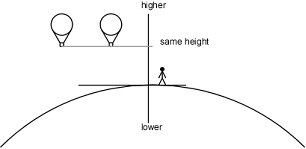
|
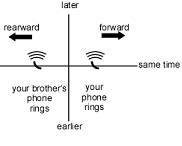
|
Next we see, on the left, the same two balloons, but with heights as determined by a different observer not at the restaurant. On the right, we have the same two phone calls, but with times of occurrence as determined by our patrol officer, who had a different velocity with respect to the road (namely, zero).
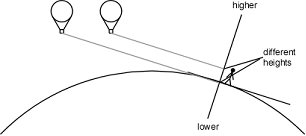
|
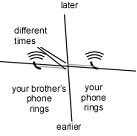
|
Note that, while the balloons were at the same height in your frame of reference, someone who has a different set of horizontal planes sees the balloons as occupying different horizontal planes-in other words, as having different heights. Similarly, although you and your brother received phone calls at the same time in your reference frame, the patrol officer has a different set of "equal-time planes". To the officer, your brother's phone rang first.
The fact that the space and time axes in Minkowski diagrams are rotated in opposite directions for different velocities illustrates the peculiar relationship between space and time that Einstein discovered. Just as the vertical and horizontal directions of space are different at different points on earth, the directions of time and space are also different for different velocities. Much as we found for our earth-location diagram,
For each velocity through space, the directions of time and space are different.
The angle by which the time axes differ for different velocities directly corresponds to the angle by which the space directions differ at those locations.
To people passing you on the highway, your phone call is the one that arrives first.
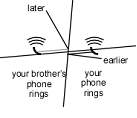
For the time differences between calls to be as obvious as these diagrams suggest, the vehicle speeds would have to be very large. In practice, even highway speeds of over 100 kilometers per hour are much too slow to make the time difference between phone calls noticeable, just as people watching the balloons while standing very close to each other would not perceive the balloons' heights very differently. For speeds at which automobiles actually move, the ends of the other observers' space and time axes would have to be drawn about an atom's width from the ends of your space and time axes, so we wouldn't be able to tell the difference just by looking at the diagrams.
Different time spans between the same events in different reference frames are more obvious in experiments with high-speed objects, very precise clocks, or both. Nonetheless, the time differences between your phone calls in the other frames of reference, while imperceptibly small, still exist and are quite real. (.....continued)


 |
Information
Bridge • Energy
Citations Database • E-print
Network • R&D
Accomplishments
About OSTI Science.gov • USA.gov • USAJOBS • Grants • Regulations.gov |
|---|